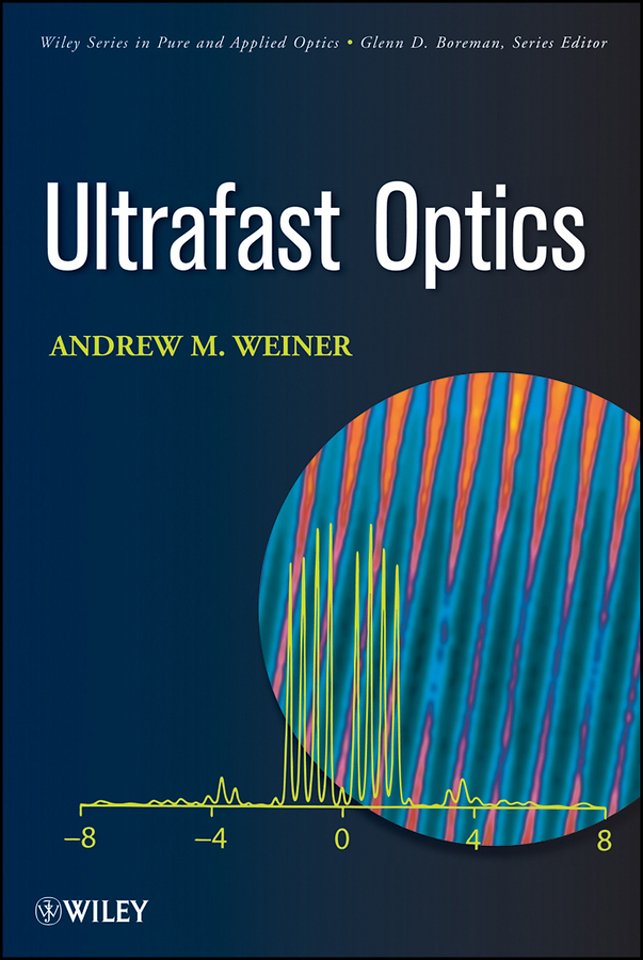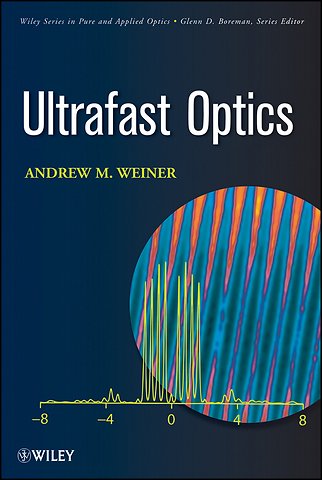Ultrafast Optics
Samenvatting
A comprehensive treatment of ultrafast optics
This book fills the need for a thorough and detailed account of ultrafast optics. Written by one of the most preeminent researchers in the field, it sheds new light on technology that has already had a revolutionary impact on precision frequency metrology, high–speed electrical testing, biomedical imaging, and in revealing the initial steps in chemical reactions.
Ultrafast Optics begins with a summary of ultrashort laser pulses and their practical applications in a range of real–world settings. Next, it reviews important background material, including an introduction to Fourier series and Fourier transforms, and goes on to cover:
Principles of mode–locking
Ultrafast pulse measurement methods
Dispersion and dispersion compensation
Ultrafast nonlinear optics: second order
Ultrafast nonlinear optics: third order
Mode–locking: selected advanced topics
Manipulation of ultrashort pulses
Ultrafast time–resolved spectroscopy
Terahertz time–domain electromagnetics
Professor Weiner′s expertise and cutting–edge research result in a book that is destined to become a seminal text for engineers, researchers, and graduate students alike.
Specificaties
Inhoudsopgave
<p>1 Introduction and Review 1</p>
<p>1.1 Introduction to Ultrashort Laser Pulses 1</p>
<p>1.2 Brief Review of Electromagnetics 4</p>
<p>1.2.1 Maxwell s Equations 4</p>
<p>1.2.2 The Wave Equation and Plane Waves 6</p>
<p>1.2.3 Poynting s Vector and Power Flow 8</p>
<p>1.3 Review of Laser Essentials 10</p>
<p>1.3.1 Steady–State Laser Operation 10</p>
<p>1.3.2 Gain and Gain Saturation in Four–Level Atoms 15</p>
<p>1.3.3 Gaussian Beams and Transverse Laser Modes 17</p>
<p>1.4 Introduction to Ultrashort Pulse Generation Through Mode–Locking 22</p>
<p>1.5 Fourier Series and Fourier Transforms 25</p>
<p>1.5.1 Analytical Aspects 25</p>
<p>1.5.2 Computational Aspects 28</p>
<p>Problems 30</p>
<p>2 Principles of Mode–Locking 32</p>
<p>2.1 Processes Involved in Mode–Locking 32</p>
<p>2.2 Active Mode–Locking 33</p>
<p>2.2.1 Time–Domain Treatment 34</p>
<p>2.2.2 Frequency–Domain Treatment 40</p>
<p>2.2.3 Variations of Active Mode–Locking 43</p>
<p>2.3 Passive Mode–Locking Using Saturable Absorbers 44</p>
<p>2.3.1 Saturation Model 47</p>
<p>2.3.2 Slow Saturable Absorber Mode–Locking 50</p>
<p>2.3.3 Fast Saturable Absorber Mode–Locking 54</p>
<p>2.4 Solid–State Laser Mode–Locking Using the Optical Kerr Effect 57</p>
<p>2.4.1 Nonlinear Refractive Index Changes 57</p>
<p>2.4.2 Self–Amplitude Modulation Self–Phase Modulation and Group Velocity Dispersion 58</p>
<p>2.4.3 Additive Pulse Mode–Locking 60</p>
<p>2.4.4 Kerr Lens Mode–Locking 64</p>
<p>2.4.5 Mode–Locking Solutions 75</p>
<p>2.4.6 Initiation of Mode–Locking 81</p>
<p>Problems 83</p>
<p>3 Ultrafast–pulse Measurement Methods 85</p>
<p>3.1 Terminology and Definitions 85</p>
<p>3.2 Electric Field Autocorrelation Measurements and the Power Spectrum 88</p>
<p>3.3 Electric Field Cross–Correlation Measurements and Spectral Interferometry 91</p>
<p>3.3.1 Electric Field Cross–Correlation 92</p>
<p>3.3.2 Spectral Interferometry 93</p>
<p>3.3.3 Application: Optical Coherence Tomography 96</p>
<p>3.4 Intensity Correlation Measurements 99</p>
<p>3.4.1 Correlation Measurements Using Second–Harmonic Generation 99</p>
<p>3.4.2 Experimental Procedures 108</p>
<p>3.4.3 Correlation Measurements Using Two–Photon absorption 110</p>
<p>3.4.4 Higher–Order Correlation Techniques 111</p>
<p>3.5 Chirped Pulses and Measurements in the Time Frequency Domain 112</p>
<p>3.6 Frequency–Resolved Optical Gating 118</p>
<p>3.6.1 Polarization–Gating FROG 119</p>
<p>3.6.2 Self–Diffraction FROG 122</p>
<p>3.6.3 Second–Harmonic–Generation FROG 124</p>
<p>3.6.4 Frequency–Resolved Optical Gating Using Temporal Phase Modulation 125</p>
<p>3.6.5 Signal Recovery from FROG Traces 126</p>
<p>3.7 Pulse Measurements Based on Frequency Filtering 130</p>
<p>3.7.1 Single–Slit Approaches 131</p>
<p>3.7.2 Double–Slit Approach 134</p>
<p>3.8 Self–Referencing Interferometry 135</p>
<p>3.8.1 Time–Domain Interferometry of Chirped Pulses 135</p>
<p>3.8.2 Self–Referencing Spectral Interferometry 137</p>
<p>3.9 Characterization of Noise and Jitter 139</p>
<p>Problems 144</p>
<p>4 Dispersion and Dispersion Compensation 147</p>
<p>4.1 Group Velocity Dispersion 147</p>
<p>4.1.1 Group Velocity Definition and General Dispersion Relations 147</p>
<p>4.1.2 General Aspects of Material Dispersion 151</p>
<p>4.2 Temporal Dispersion Based on Angular Dispersion 155</p>
<p>4.2.1 Relation Between Angular and Temporal Dispersion 155</p>
<p>4.2.2 Angular Dispersion and Tilted Intensity Fronts 159</p>
<p>4.3 Dispersion of Grating Pairs 161</p>
<p>4.4 Dispersion of Prism Pairs 166</p>
<p>4.5 Dispersive Properties of Lenses 173</p>
<p>4.6 Dispersion of Mirror Structures 177</p>
<p>4.6.1 The Gires Tournois Interferometer 178</p>
<p>4.6.2 Quarter–Wave Stack High Reflectors 180</p>
<p>4.6.3 Chirped Mirrors 182</p>
<p>4.7 Measurements of Group Velocity Dispersion 186</p>
<p>4.7.1 Interferometric Methods 187</p>
<p>4.7.2 Frequency–Domain Intracavity Dispersion Measurements 190</p>
<p>4.8 Appendix 191</p>
<p>4.8.1 Frequency–Dependent Phase Due to Propagation Through a Slab: Alternative Derivation 191</p>
<p>4.8.2 Impedance Method for Analysis of Dielectric Mirror Stacks 192</p>
<p>Problems 195</p>
<p>5 Ultrafast Nonlinear Optics: Second Order 198</p>
<p>5.1 Introduction to Nonlinear Optics 198</p>
<p>5.2 The Forced Wave Equation 201</p>
<p>5.2.1 Frequency–Domain Formulation 202</p>
<p>5.2.2 Time–Domain Formulation 203</p>
<p>5.3 Summary of Continuous–Wave Second–Harmonic Generation 204</p>
<p>5.3.1 Effect of Phase Matching 207</p>
<p>5.3.2 Phase Matching in Birefringent Media 209</p>
<p>5.3.3 Focusing Effects in Continuous–Wave SHG 215</p>
<p>5.4 Second–Harmonic Generation with Pulses 220</p>
<p>5.4.1 SHG in the Quasi–Continuous–Wave Limit 220</p>
<p>5.4.2 Ultrashort–Pulse SHG 221</p>
<p>5.4.3 Quasi–Phase Matching 228</p>
<p>5.4.4 Effect of Group Velocity Walk–off on SHG–Based Pulse Measurements 233</p>
<p>5.5 Three–Wave Interactions 237</p>
<p>5.5.1 Sum Frequency Generation 240</p>
<p>5.5.2 Difference Frequency Generation 244</p>
<p>5.5.3 Optical Parametric Amplification 245</p>
<p>5.6 Appendix 253</p>
<p>5.6.1 Spatial Walk–off and Pulse Fronts in Anisotropic Media 253</p>
<p>5.6.2 Velocity Matching in Broadband Noncollinear Three–Wave</p>
<p>Mixing 254</p>
<p>Problems 256</p>
<p>6 Ultrafast Nonlinear Optics: Third Order 258</p>
<p>6.1 Propagation Equation for Nonlinear Refractive Index Media 258</p>
<p>6.1.1 Plane Waves in Uniform Media 260</p>
<p>6.1.2 Nonlinear Propagation in Waveguides 261</p>
<p>6.1.3 Optical Fiber Types 264</p>
<p>6.2 The Nonlinear Schr¨odinger Equation 266</p>
<p>6.3 Self–Phase Modulation 270</p>
<p>6.3.1 Dispersionless Self–Phase Modulation 270</p>
<p>6.3.2 Dispersionless Self–Phase Modulation with Loss 273</p>
<p>6.3.3 Self–Phase Modulation with Normal Dispersion 274</p>
<p>6.3.4 Cross–Phase Modulation 275</p>
<p>6.4 Pulse Compression 276</p>
<p>6.5 Modulational Instability 283</p>
<p>6.6 Solitons 286</p>
<p>6.7 Higher–Order Propagation Effects 291</p>
<p>6.7.1 Nonlinear Envelope Equation in Uniform Media 292</p>
<p>6.7.2 Nonlinear Envelope Equation in Waveguides 295</p>
<p>6.7.3 Delayed Nonlinear Response and the Raman Effect 296</p>
<p>6.7.4 Self–Steepening 306</p>
<p>6.7.5 Space Time Focusing 308</p>
<p>6.8 Continuum Generation 310</p>
<p>Problems 313</p>
<p>7 Mode–Locking: Selected Advanced Topics 316</p>
<p>7.1 Soliton Fiber Lasers: Artificial Fast Saturable Absorbers 316</p>
<p>7.1.1 The Figure–Eight Laser 317</p>
<p>7.1.2 Energy Quantization 322</p>
<p>7.1.3 Soliton Sidebands 324</p>
<p>7.2 Soliton Mode–Locking: Active Modulation and Slow Saturable Absorbers 328</p>
<p>7.2.1 Harmonically Mode–Locked Soliton Fiber Lasers 328</p>
<p>7.2.2 The Net Gain Window in Soliton Mode–Locking 330</p>
<p>7.3 Stretched Pulse Mode–Locking 337</p>
<p>7.3.1 Stretched Pulse Mode–Locked Fiber Laser 337</p>
<p>7.3.2 Dispersion–Managed Solitons 340</p>
<p>7.3.3 Theoretical Issues 342</p>
<p>7.4 Mode–Locked Lasers in the Few–Cycle Regime 344</p>
<p>7.5 Mode–Locked Frequency Combs 347</p>
<p>7.5.1 Comb Basics 347</p>
<p>7.5.2 Measurement Techniques 350</p>
<p>7.5.3 Stabilization of Frequency Combs 354</p>
<p>7.5.4 Applications 356</p>
<p>Problems 360</p>
<p>8 Manipulation of Ultrashort Pulses 362</p>
<p>8.1 Fourier Transform Pulse Shaping 362</p>
<p>8.1.1 Examples of Pulse Shaping Using Fixed Masks 364</p>
<p>8.1.2 Programmable Pulse Shaping 369</p>
<p>8.1.3 Pulse–Shaping Theory 376</p>
<p>8.2 Other Pulse–Shaping Techniques 386</p>
<p>8.2.1 Direct Space–to–Time Pulse Shaping 386</p>
<p>8.2.2 Acousto–optic Dispersive Filters 390</p>
<p>8.3 Chirp Processing and Time Lenses 394</p>
<p>8.3.1 Space Time Duality 394</p>
<p>8.3.2 Chirp Processing 397</p>
<p>8.3.3 Time Lens Processing 399</p>
<p>8.4 Ultrashort–Pulse Amplification 405</p>
<p>8.4.1 Amplification Basics 406</p>
<p>8.4.2 Special Issues in Femtosecond Amplifiers 411</p>
<p>8.5 Appendix 416</p>
<p>8.5.1 Fresnel Diffraction and Fourier Transform Property of a Lens 416</p>
<p>8.5.2 Wave Optics Model of a Grating 418</p>
<p>Problems 420</p>
<p>9 Ultrafast Time–Resolved Spectroscopy 422</p>
<p>9.1 Introduction to Ultrafast Spectroscopy 422</p>
<p>9.2 Degenerate Pump Probe Transmission Measurements 426</p>
<p>9.2.1 Co–polarized Fields: Scalar Treatment 426</p>
<p>9.2.2 Vector Fields and Orientational Effects 431</p>
<p>9.3 Nondegenerate and Spectrally Resolved Pump Probe: Case Studies 439</p>
<p>9.3.1 Femtosecond Pump Probe Studies of Dye Molecules 440</p>
<p>9.3.2 Femtosecond Pump Probe Studies of GaAs 444</p>
<p>9.4 Basic Quantum Mechanics for Coherent Short–Pulse Spectroscopies 451</p>
<p>9.4.1 Some Basic Quantum Mechanics 451</p>
<p>9.4.2 The Density Matrix 456</p>
<p>9.5 Wave Packets 460</p>
<p>9.5.1 Example: Semiconductor Quantum Wells 461</p>
<p>9.5.2 Molecules 462</p>
<p>9.6 Dephasing Phenomena 469</p>
<p>9.6.1 Linear Spectroscopies 469</p>
<p>9.6.2 Models of Dephasing 475</p>
<p>9.6.3 Measurement of Dephasing Using Transient Gratings 481</p>
<p>9.6.4 Two–Dimensional Spectroscopy 494</p>
<p>9.7 Impulsive Stimulated Raman Scattering 499</p>
<p>Problems 505</p>
<p>10 Terahertz Time–Domain Electromagnetics 507</p>
<p>10.1 Ultrafast Electromagnetics: Transmission Lines 507</p>
<p>10.1.1 Photoconductive Generation and Sampling 507</p>
<p>10.1.2 Electro–optic Sampling 513</p>
<p>10.2 Ultrafast Electromagnetics: Terahertz Beams 516</p>
<p>10.2.1 Generation and Measurement of Terahertz Pulses 517</p>
<p>10.2.2 Terahertz Spectroscopy and Imaging 527</p>
<p>Problems 531</p>
<p>References 533</p>
<p>Index 563</p>

